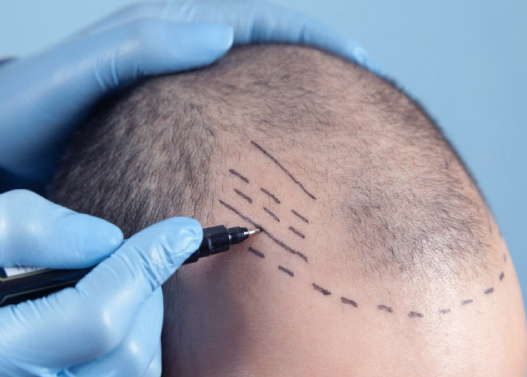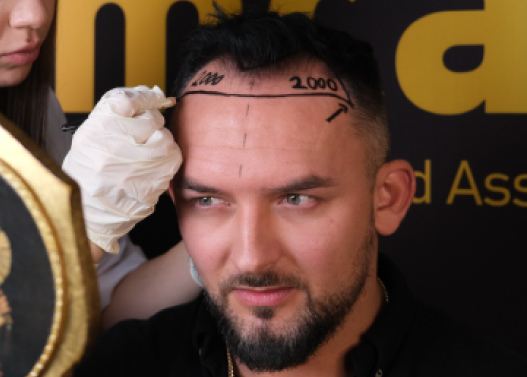Hair Graft Calculator
Estimate how many hair grafts you need for a natural-looking hair transplant. Our easy-to-use hair transplant graft calculator helps you plan your hair restoration journey with confidence.
Featured in:
Knowing how many hair grafts you need is a crucial step in planning a successful hair transplant. A graft calculator provides a quick and convenient way to estimate the number of grafts required based on your hair loss stage, the area of coverage needed, and your desired hair density. Whether you’re in the early stages of thinning or dealing with advanced hair loss, this tool helps you take the first step toward achieving natural-looking results with a hair transplant in Turkey.

How does Hair Transplant Graft Calculator Work?
Hair Graft Calculator is a simple yet powerful tool designed to help you estimate the number of grafts needed for a successful hair transplant. By taking into account factors such as your age, specific areas of hair loss, and desired hair density, this calculator provides a personalized estimate that can guide your hair restoration planning. Whether you’re dealing with a receding hairline or more extensive thinning, understanding your graft needs is an important first step toward achieving your hair goals.
The calculator works by analyzing the coverage needed across different scalp areas and translating this into the number of grafts and hair follicles required to achieve natural-looking results. Each selected area and density preference contributes to a precise estimate, helping you make informed decisions about the hair transplant process.
How to use Graft Calculator?
Step 1:
Select Your Age
Click on the blue button displaying the number “18” and choose your age. This helps the calculator provide a more accurate estimate based on age-related hair loss patterns.
Step 2:
Identify Hair Loss Areas
Hover over the scalp images and click on the areas where you are experiencing balding or receding hair. This allows the calculator to assess the coverage needed.
Step 3:
Set Your Desired Hair Density
Use the slider bar to indicate how much fullness you’d like to achieve. Slide to the right for complete fullness or adjust to match your desired look.
The Results
- Hair: Shows the total number of hair follicles required to achieve your desired density.
- Grafts: Displays the estimated number of grafts needed for your transplant.
How Many Grafts Do You Need?
The number of hair grafts needed for a hair transplant depends on factors like the size of the treatment area, your desired hair density, and the quality of your donor area. Generally, the required graft count can vary as follows:
- Hairline Restoration: Approximately 1,000-2,000 grafts to enhance a receding hairline.
- Crown Coverage: Typically requires 1,500-2,500 grafts, depending on the size of the bald spot.
- Full Head Coverage: Can need anywhere from 4,000 to 6,000+ grafts, particularly for those with extensive hair loss.
- Adding Density: To achieve a fuller look, 500-1,500 grafts may be enough for thinning areas.
For a more detailed look into graft counts and how to determine the right number for your hair transplant, visit our in-depth blog article: Hair Transplant Graft Counts: How to Know the Right Number for You


How Many Grafts Do You Need?
Our Hair Graft Calculator provides an approximate estimate as the exact number of grafts needed can vary from person to person. Factors such as hair type, head size, and donor area quality all play a role in determining the final graft count. For a precise assessment, it’s essential to consult with an experienced hair transplant surgeon.
Please fill out our contact form to receive a personalized evaluation and expert guidance.
FAQ

Didn’t find your question?
You can ask any questions you have regarding Hair Grafts right now!
The Hair Graft Calculator provides a helpful estimate of the number of grafts needed for a hair transplant, based on inputs like age, hair loss area, and desired density. While it offers a good starting point, the result is an approximation. Individual factors such as hair type, scalp condition, and donor area quality can affect the final graft count. For the most accurate assessment, a professional consultation with a hair transplant specialist is recommended.
A graft is a small piece of skin containing hair follicles, which is transplanted to a balding area during a hair transplant. Each graft typically contains 1 to 4 hair follicles, depending on the extraction method and the donor area’s characteristics. The term “graft” refers to the unit being moved, while “hair follicles” describe the actual hair-producing structures within the graft.
A single graft generally contains 2 to 4 hair follicles, although this can vary. Follicular Unit Extraction (FUE) and Direct Hair Implantation (DHI) techniques often focus on natural follicular units, which include groups of 1 to 4 hairs. The variation in follicle count per graft allows specialists to create a natural-looking hairline and improve density in thinning areas.
Several factors influence the graft count required for a hair transplant, including:
• Hair Loss Stage: More advanced stages on the Norwood-Hamilton Scale require more grafts.
• Desired Density: Fuller coverage demands a higher number of grafts.
• Treatment Area Size: Larger areas of hair loss need more grafts.
• Hair Characteristics: Thickness, color, and texture can affect how well the transplanted hair covers the scalp.
• Donor Area Quality: The availability and strength of donor hair play a crucial role in determining the feasibility of a transplant.
The Hair Graft Calculator is primarily designed for estimating graft needs in male pattern baldness, using the Norwood-Hamilton Scale. While it can provide insights for female pattern hair loss and other types of alopecia, these conditions often require a more individualized assessment. For non-standard hair loss patterns, a consultation with a specialist is recommended to ensure an accurate evaluation and treatment plan.
If the Hair Graft Calculator suggests a high graft count, the next step is to consult a hair transplant specialist. They can evaluate your donor area capacity, explore alternative techniques such as scalp micropigmentation (SMP), or suggest combination treatments to achieve the best possible results. High graft needs may also indicate the need for multiple sessions or a strategic approach to prioritize key areas of the scalp.